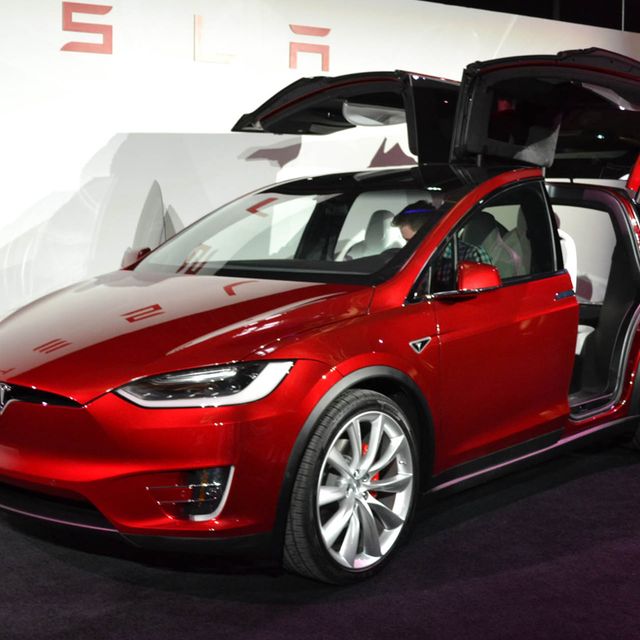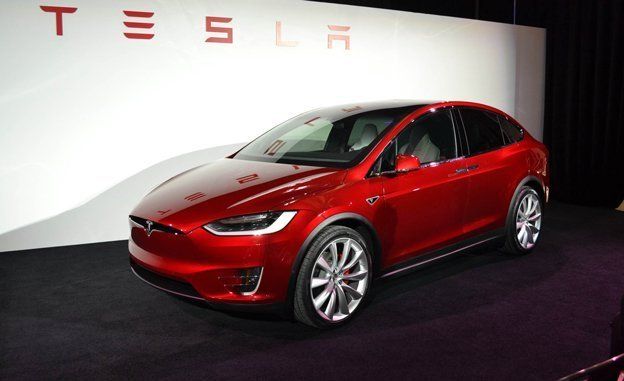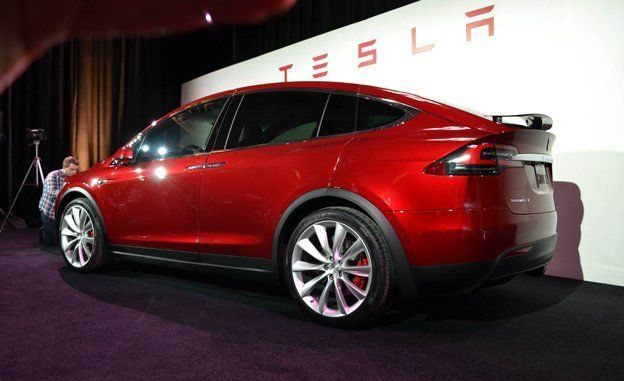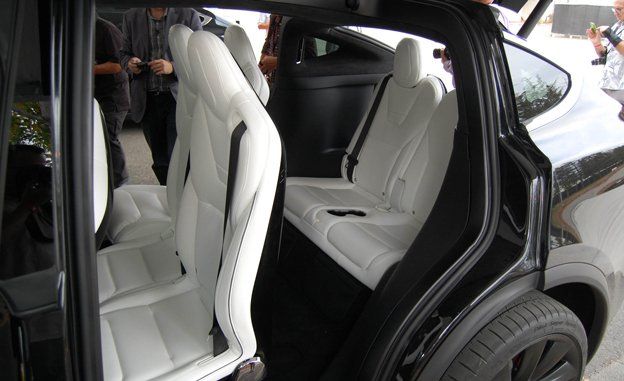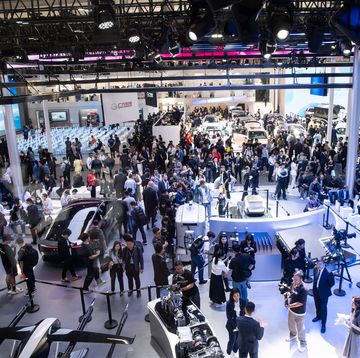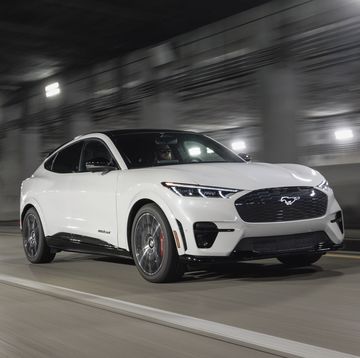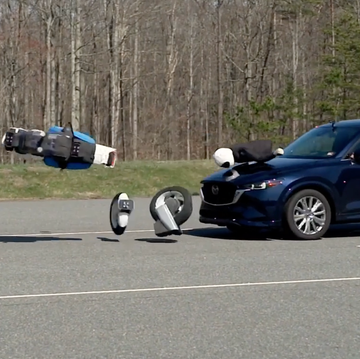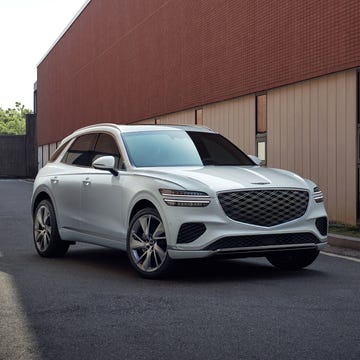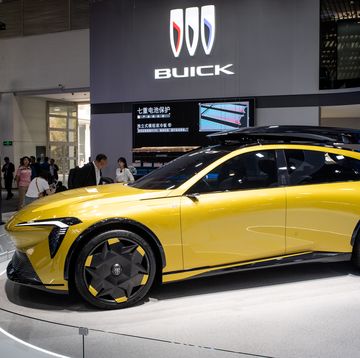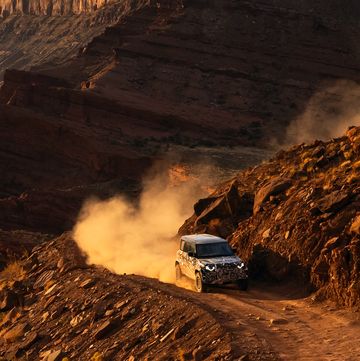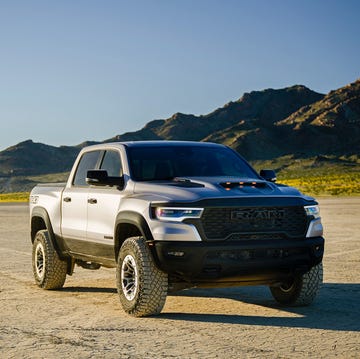It’s called the Tesla Model X, but it should probably be called “Elon’s Headache.” Behold, finally, Tesla’s two-and-a-half-ton electric sport-utility vehicle that shows, in Elon Musk’s own words, that “I think we got a little carried away.” There are those much-ballyhooed “falcon wing” motorized doors with their multiple hinges and a brace of ultrasonic and capacitive sensors to prevent disaster; the self-opening and -closing front doors; the “monoposto” middle-row seats that put their passengers on stout, movable pedestals; a massive wrap-over windshield that necessitated the world’s most unnecessarily complicated sun visors; and a HEPA cabin filter that, says company founder Elon, creates “hospital operating room cleanliness in the car.”
How does the X drive? Like the Tesla Model S on which much of the parts below the floor are based. Spear-sharp steering and governed body roll make for a grace that utterly belies the extra thousand pounds on the Model X’s back. Owners of a Porsche Cayenne Turbo S would recognize the way the car’s acceleration squishes all six (or seven, depending on the configuration) passengers into their seats—and the way it seems to flaunt physics.
In a short drive around a cone course near Tesla’s manufacturing facility, we drove a Model X P90D, the hyperfast version with the so-called “Ludicrous” acceleration mode. Stated curb weight: 5441 pounds. Towing capacity: 5000 pounds. The driver sits high but the bodywork rises such that it just feels like a Model S on jackstands. The different view is up, where a wave of shaded glass flows over your head, standing in for the windshield-header beam and sun visors on most cars. The sun visors attach to the A-pillar and can be stretched across the cabin to magnetic posts to create a sun shield. The windshield, says Musk, is made from seven layers (“like a tiramisu”), and he also figures it’s the largest piece of glass in a production car.
All of the doors, from the front to the hatchback, open and close at the push of a button. The falcon doors, attached to a massive magnesium spine for rollover protection, motor in a leisurely fashion, rising in an arc determined by the proximity of obstacles as detected by the many sensors. Even when there are no cars or people or posts around, it’s not a fast movement, so your entrance is like that of a Broadway star waiting for the curtain to rise. Tesla says the doors extend outward by just 11.8 inches. We weren’t able to take the X on the freeway or open the doors in a downpour to see how well they seal. Tesla is leaving that to the car’s first beta testers . . . er, customers.
In Tesla fashion, Musk held a massive party at the company’s Fremont, California, headquarters to deliver the first new Model Xs to six lucky front-of-the-liners. (There are currently some 30,000 orders, says Tesla, and the wait right now is 9 to 12 months.) Two versions are offered initially: the $132,000 P90D Signature and the faster, sportier $142,000 P90D Founder that includes the Ludicrous mode. Musk says the general price premium versus a Model S will be about $5000, and less-expensive versions will come later. We expect that the non-P 90D will start at less than $100,000 and that a 70D will cost about $80,000. All Model Xs will be all-wheel drive, at least initially. Smaller batteries are coming later and perhaps two-wheel-drive versions, as well.
EPA-rated range for the 90D is 257 miles, and that model also sees an efficiency rating of 92 MPGe. The P90D is rated for 250 miles on a full charge, as well as 89 MPGe. Zero-to-60-mph times, Tesla claims, come in at 4.8 seconds for the 90D, 3.8 for the P90D, and 3.2 seconds for the P90D in Ludicrous mode. Stated output for the P90D is 762 horsepower (259 from the front electric motor, 503 from the rear) and 713 lb-ft of torque.
Wheel sizes range from 20 to 22 inches, and the air suspension has five settings that allow it to provide as much as nine inches of clearance for—ahem—off-roading and as little as 6.5 inches for highway driving. Sonar sensors work in 360 degrees to enable Tesla’s “advanced autopilot features,” and the automatic emergency braking system will operate “at high speed.”
The winged doors and the one-post seats were some of the biggest challenges, moving in what Musk describes as “balletic motion,” but they also add big functionality. The pedestals supporting the middle seats motor back and forth to make rear-seat entry easy, and they allow a lot of stuff to be stored underneath. However, they don’t actually fold flat, as does the rearmost row. Tesla says the amount of space in the cabin combined with the “frunk” up front creates more than enough room.
Most automaker executives would never admit a mistake, but this is Elon Musk. In his own words: “I’m not sure anyone should really make this car. There are far more things there than is needed to sell it.” Maybe, but it’s hard to fault a car for being too interesting.
